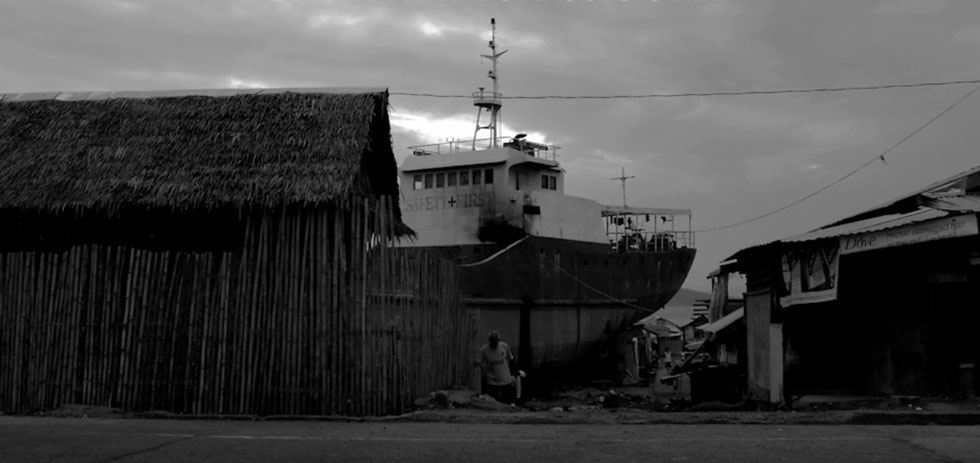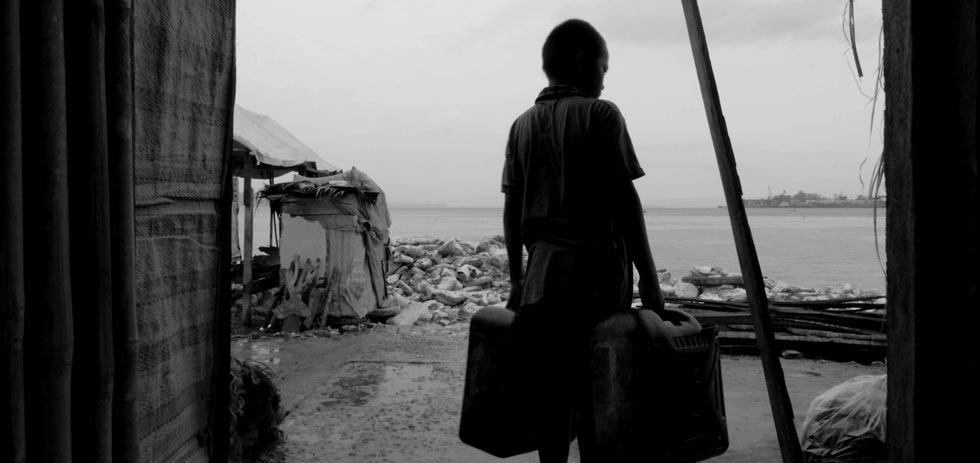
There have been countless films to toy with the line between fiction and documentary filmmaking, through authorial intrusions and winks to form, jumping back and forth between the two styles. Lav Diaz’s latest, Storm Children – Book One, seeks to remove the distinction altogether, by making it not impossible to discern the divide, but by making the very question irrelevant. He has continued to make his own cinema, image-making in the purest sense, free from the niggling issues that undermined his previous two excursions into narrative features, Norte, the End of History and From What Is Before, while almost entirely eschewing hallmarks of traditional non-fiction filmmaking. It’s a mesmerising, beautiful film that wordlessly transmits its vision while also playing with Diaz’s continual fascination with time and duration.
Shot in the aftermath of Taiphoon Haiyan, one of the worst natural disasters in the history of the Philippines, Diaz’s film is composed of a number of scenes – or more precisely, shots – following children in the rubble. Following children around overflowing storm drains, along beaches covered with strewn debris and other sights, much of the film simply captures two children sifting through rubbish. Whether this is a game or an attempt to scavenge for whatever can be found is unclear; both boredom and more material deprivation could be seen to be strong determinants for the film’s scant plot. We don’t know much about these children, or how the project came about. There’s no voiceover or infographic contextualising or introducing the “action”, yet we come away with just a slight suspicion that this isn’t a fly-on-the-wall exercise in observation. Their movement is almost always restrained to within the frame, and the characters show an inhuman ability to ignore the presence of a camera and crew while concentrating on their Sisyphean tasks (capturing boxes in the river with sticks, digging among mulch-like debris to little discovery) for unbroken shots of 15 minutes at a time – though this could also be attributed to simple childlike lack of self-consciousness and imagination. Whether scenes are partly or wholly organised or manufactured seems unimportant, as our attention focuses elsewhere.
Diaz, one of the most renowned (or depending on your threshold for this sort of thing, notorious) masters of ‘slow cinema’, is working in his primary mode of constructing a film. Some reviews have labelled this ‘minor’ Diaz (and the film is uncharacteristically short, in relative terms, at a shade under two-and-a-half hours) but his long take aesthetic, utilising the possibilities of digital cinema like few others, works wonders. Unbroken, still shots of repetitive motions and a soundtrack of purely diegetic influences makes the film engrossing, but its lack of narrative indices or propulsion means the film demands a lot of active participation in the viewer, often to a confounding but liberating effect. Combined with a more cynical and simple background knowledge – that we’re in for a long haul – exactly what we’re supposed to be doing as the audience is something we occasionally get anxious about in a Diaz film. Close attention is rewarded, with tiny details such as a boy’s briefs showing a misspelt “Addidas” label, a bus with a front placard saying “BRO + SIS” looming large as either clues to further understanding the film’s socio-cultural environment, or, in the latter’s case, confounding even further. At times the spectator tries to get into the heads of the film’s subjects, at times our eyes dart around the composition, fixating on those details, and at times, it must be said, our attention will wander as we fall into our own thoughts. Diaz respects his audience, but he doesn’t have unrealistic expectations of them.

The film is shot gorgeously in black-and-white; the monochrome aesthetic turns the bodies and avenues of water into dark, inky blacks and greys, evoking the fear and unpredictability these disasters continually wreak upon these communities. The latter half of the film is particularly striking, set in a village of shanty seaside houses, most destroyed beyond recognition. In amongst them are giant, empty cargo ships run aground and looming over the makeshift houses on the waterfront. Diaz shoots these to amazing effect, whether it is a man escaping the rain under a ship’s hull, or a shot of one of these alien, gargantuan symbols of technology and commerce resting upon the rubble of destroyed local businesses; a visual irony that would register as too obvious a metaphor if it hadn’t eventuated out of the whims of nature.1 It’s the sort of landscape that a dystopian blockbuster would spend $100 million dollars in building, and to less thematic and visual effect.
The final act is briefly punctuated by Diaz revealing his hand from behind the camera, in multiple ways. He finally briefly interviews the two boys we’ve been following for two hours2 and then reverts to a different style of shooting, with one of the shakiest tracking shots I’ve ever encountered, and then has a coughing fit during the film’s final, sublime sequence. Whether it’s intentional or not, the cumulative effect of these tics is that Diaz comes across like a world-class image-maker, but that he needn’t be much more hands-on than that. The aforementioned final scene captures the potential of his cinema perfectly realised. Shot from what seems like a raft, it’s a long scene of children playing around two abandoned cargo ships floating in the ocean, jumping off increasingly high decks and guardrails and packing onto wooden rafts floating below. After two-and-a-half hours of meditative, actionless cinema the effect is positively thrilling and overstimulating; a tangible sense of adventure and danger as fearless kids throw themselves into the ocean, an act rich with subtext – whether as an act of reclaiming the forces of nature that have ravaged the community, as life imitating art (Diaz finds several shots that feel like real-life cinematic references; I couldn’t watch the final scene without thinking of Buster Keaton’s The Navigator and occasionally Jerry Lewis’ The Ladies Man in its ‘set’ construction), or of the innocence of children triumphing over and flourishing in the face of collective trauma. It’s thrilling, moving cinema, capping off what was the best new film I saw at the Melbourne International Film Festival.
Around the Staff:
| Ivan Cerecina |
